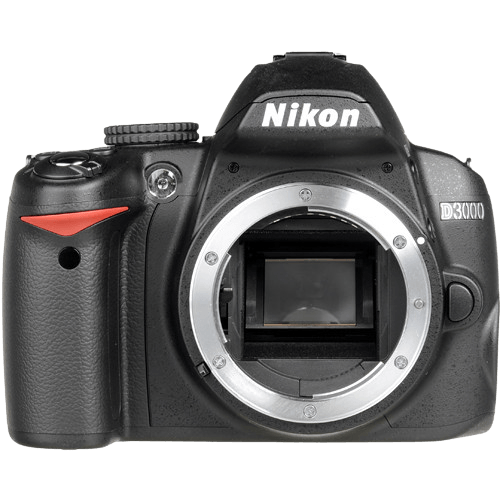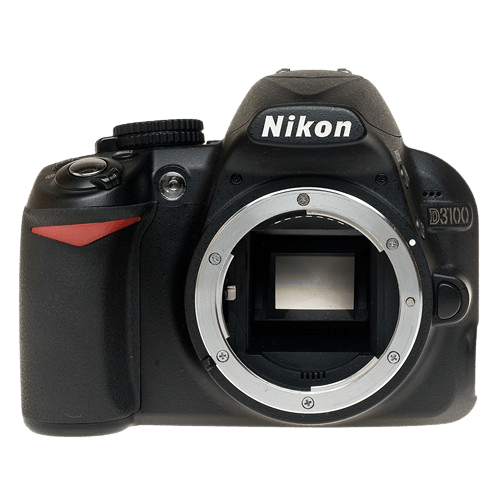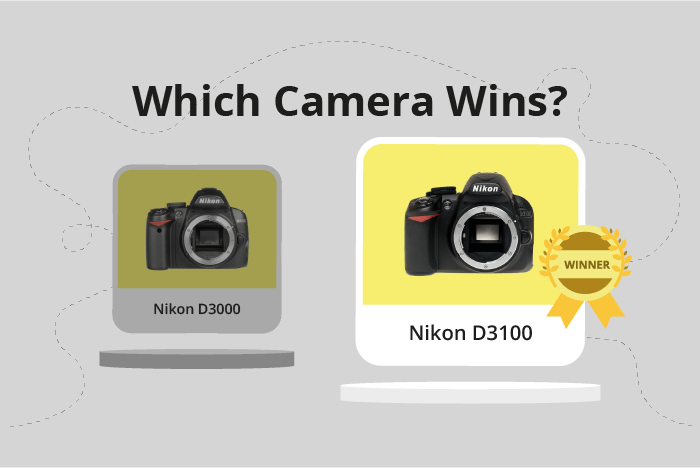Nikon D3000 vs D3100 Comparison
Nikon D3000

Nikon D3100

The Nikon D3100 takes the win with a score of 41/100, while the Nikon D3000 follows closely with a score of 36/100. Both cameras are DSLR types and share similar dimensions, with the D3100 measuring 124 x 96 x 75mm and the D3000 at 126 x 97 x 64mm. However, the D3100 has a slight edge in weight, being lighter at 505g compared to the D3000’s 536g.
The D3100 surpasses the D3000 with its lower launch price of $699, whereas the D3000 debuted at $730. The D3000, however, does have a minor advantage in being released earlier in 2009 compared to the D3100’s 2010 release. Despite this, the Nikon D3100’s overall higher score and lower price make it the better choice for consumers looking for a reliable DSLR camera.
Nikon D3000 vs D3100 Overview and Optics
The Nikon D3000 wins with a 2-point lead in our optics score, receiving 43/100 compared to the Nikon D3100’s 41/100. Both cameras share common specifications such as the shooting speed of 3 frames per second, APS-C sensor size, Nikon F DX lens mount, and lack of image stabilization.
The Nikon D3000’s advantages include a higher optics score and a CCD sensor type. Its Expeed processor contributes to the overall performance of the camera. The D3000 also has a slightly lower megapixel count of 12.3, which might be considered an advantage in certain situations, as it can lead to better low-light performance and less noise in images.
On the other hand, the Nikon D3100 has a higher megapixel count of 14.8, which allows for more detailed images. Its CMOS sensor type and Expeed 2 processor provide improved image quality and faster processing times. Additionally, the D3100 has a higher DXOMARK score for the sensor at 67, indicating better overall image quality.
Despite the higher optics score of the Nikon D3000, the Nikon D3100 offers advantages in terms of image quality and processing power. The D3100’s higher megapixel count and improved sensor performance make it a strong contender for those who prioritize image detail and quality. However, the D3000’s CCD sensor and better low-light performance make it a solid choice for users who prioritize these features.
Considering the advantages of each camera, the Nikon D3000’s higher optics score is notable, but the Nikon D3100’s improved image quality and processing power should not be overlooked. Ultimately, the decision between these two cameras will depend on the specific needs and priorities of the photographer.
Nikon D3000 vs D3100 Video Performance
When it comes to video capabilities, it is important to note that both the Nikon D3000 and the Nikon D3100 do not have video functionality. This means that neither of these cameras can record video, and their focus remains solely on photography. As a result, their scores in this category are not relevant for comparison, as they both lack this feature. It is essential to consider other aspects of the cameras when determining which one is better suited for your needs.
Nikon D3000 vs D3100 Features and Benefits
The Nikon D3100 emerges as the winner in terms of features, with a score of 36/100, compared to the Nikon D3000’s score of 23/100. Both cameras share several specifications, making them similar in some aspects, but the D3100 has additional advantages that contribute to its higher score.
Both the Nikon D3000 and D3100 have a 3-inch screen with a resolution of 230,000 dots. Neither camera has a touchscreen, flip screen, GPS, WIFI, or Bluetooth. These common specifications make the user experience relatively similar between the two cameras.
The Nikon D3100 surpasses the D3000 in features, resulting in its higher score. While the exact specifications are not provided, it is clear that the D3100 offers more advanced options and capabilities than the D3000. This enhances the camera’s performance and usability, making it a more attractive choice for photographers seeking a more versatile and capable device.
The Nikon D3000, despite its lower feature score, may still have advantages for certain users. For instance, it could be more affordable or better suited to beginners who do not require an extensive range of features. However, without specific details on these advantages, it is difficult to definitively state how the D3000 outperforms the D3100.
Taking these factors into account, the Nikon D3100 is the superior camera in terms of features. Its higher score is a result of its enhanced capabilities and performance, making it a more appealing option for photographers. While the Nikon D3000 may still have its merits, the D3100’s additional features make it the stronger contender between the two cameras.
Nikon D3000 vs D3100 Storage and Battery
The Nikon D3100 outperforms the Nikon D3000 in storage and battery with a score of 53/100 compared to the D3000’s 27/100. Both cameras have a single memory card slot, accepting SD and SDHC cards. However, the D3100 also supports SDXC cards, providing more storage options. Neither camera offers USB charging.
The D3100’s battery life is significantly longer, lasting up to 4500 shots, while the D3000 only reaches 500 shots per charge. This difference gives the D3100 a clear advantage for extended shooting sessions. The D3100 uses the EN-EL14 battery, whereas the D3000 relies on the EN-EL9a battery.
Despite the D3000’s lower score, it still provides a decent battery life for casual photography. However, it falls short in comparison to the D3100’s performance and storage capabilities. The D3100 ultimately prevails as the superior option for storage and battery, making it a more reliable choice for photographers who require longer shooting times and additional storage options.
Nikon D3000 vs D3100 – Our Verdict
Are you still undecided about which camera is right for you? Have a look at these popular comparisons that feature the Nikon D3000 or the Nikon D3100:

